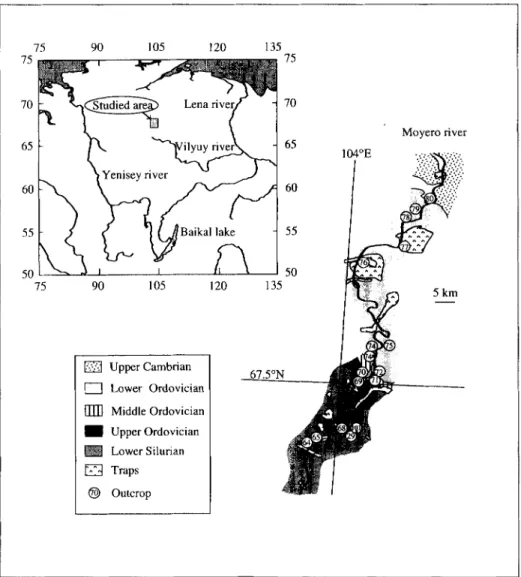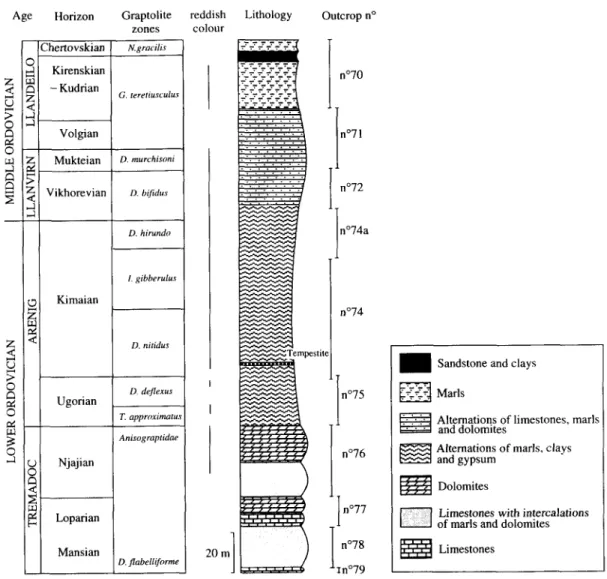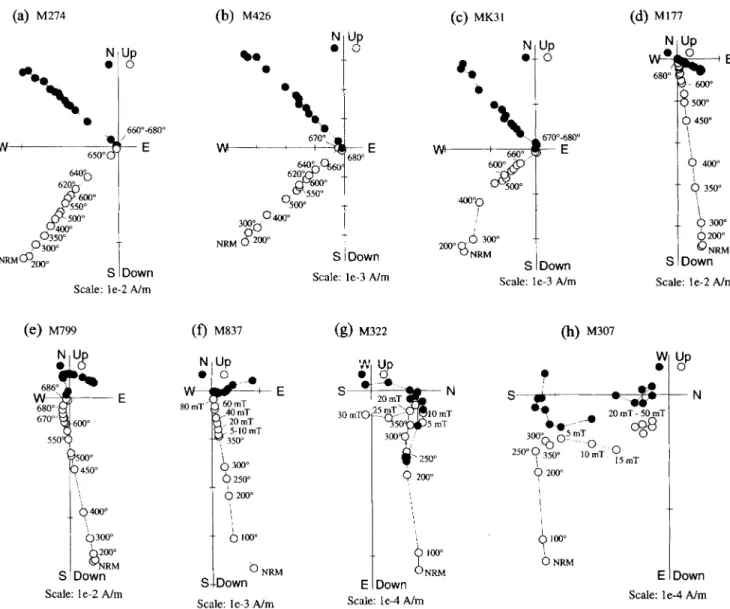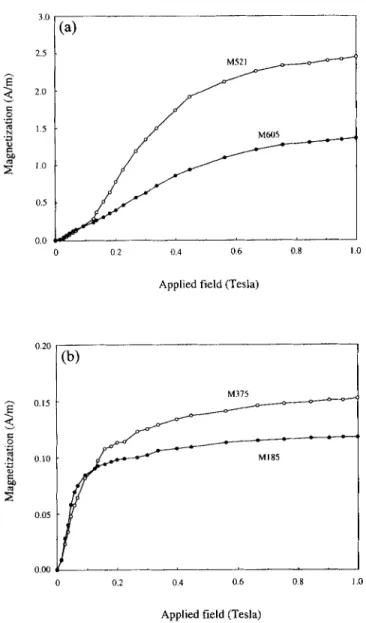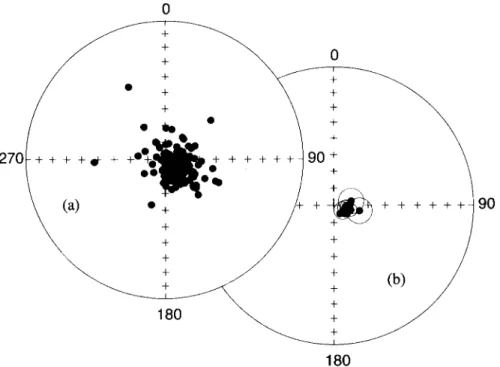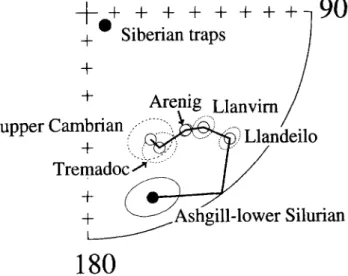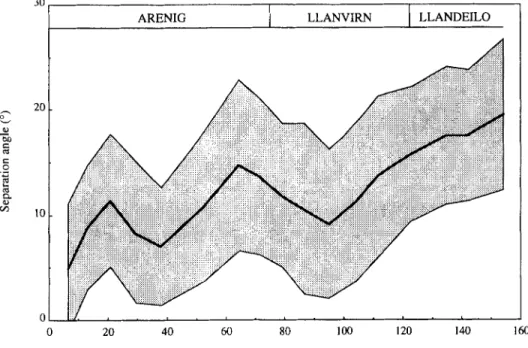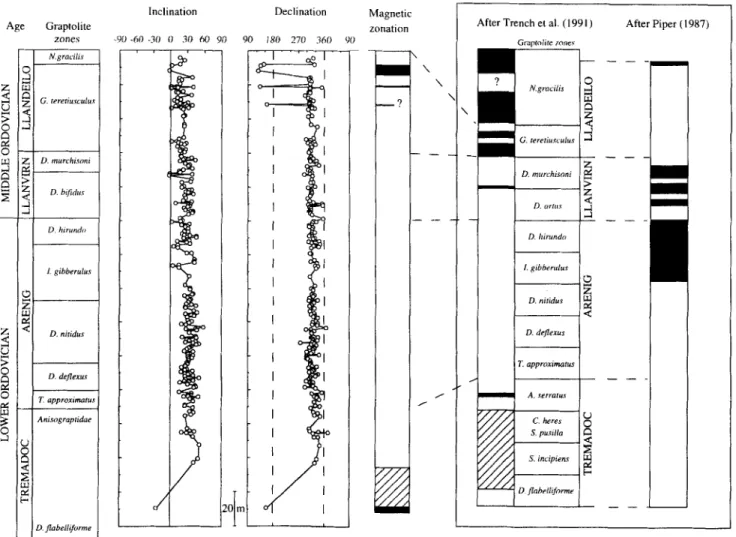HAL Id: insu-01863442
https://hal-insu.archives-ouvertes.fr/insu-01863442
Submitted on 28 Aug 2018
HAL is a multi-disciplinary open access
archive for the deposit and dissemination of
sci-entific research documents, whether they are
pub-lished or not. The documents may come from
teaching and research institutions in France or
abroad, or from public or private research centers.
L’archive ouverte pluridisciplinaire HAL, est
destinée au dépôt et à la diffusion de documents
scientifiques de niveau recherche, publiés ou non,
émanant des établissements d’enseignement et de
recherche français ou étrangers, des laboratoires
publics ou privés.
Magnetostratigraphy of the Moyero river section
(north-western Siberia): constraints on geomagnetic
reversal frequency during the early Palaeozoic
Yves Gallet ’, Vladimir Pavlov
To cite this version:
Yves Gallet ’, Vladimir Pavlov. Magnetostratigraphy of the Moyero river section (north-western
Siberia): constraints on geomagnetic reversal frequency during the early Palaeozoic. Geophysical
Journal International, Oxford University Press (OUP), 1996, 125 (1), pp.95-105.
�10.1111/j.1365-246X.1996.tb06536.x�. �insu-01863442�
Geophys. J . Int. (1996) 125,95-105
Magnetostratigraphy of the Moyero river section (north-western
Siberia): constraints on geomagnetic reversal frequency during the
early Palaeozoic
Yves Gallet' and Vladimir Pavlov2
'
Laboratoire de PalLomagndtisme (URA CNRS 729). Institut de Physique du Globe de Paris, France Department of Geomagnetism und Palueomagnetism, Institute of Physics oj'the Earth, Moscow, Ru.s.siaAccepted 1995 October 12. Received 1995 August 30; in original form 1995 February 24
S U M M A R Y
We
present the magnetostratigraphy of the early Palaeozoic Moyero river section in north-western Siberia. The section investigated, which consists mainly of reddish limestones, m a r k and greyish limestones, extends from the upper Cambrian to the lower Silurian. Palaeomagnetic analyses reveal two magnetic components. One is interpreted as a remagnetization acquired during Siberian trap emplacement; the other is believed t o be early diagenetic, consistent with the established lower Palaeozoic apparent polar wander path for Siberia. Reversed polarity dominates from the upper Cambrian to the middle Ordovician, while normal polarity dominates from the upper Ordovician to the lower Silurian. Only a few reversals, whichare
poorly defined, are observed through the section, in particular during the Llandeilo. These data are in agreement with previous magnetostratigraphic data from the Baltic platform and Siberia a n d indicate that magnetic reversal frequency was low during the Ordovician. Because of the time-delayed process of acquisition of the magnetization carried by haematite, we cannot clearly ascertain if a reversed superchron occurred during the lower t o middle Ordovician. However, o u r results suggest that a 15 Myr-long reversed interval existed during the Arenig.Key words: magnetostratigraphy, Ordovician, reversal frequency, Siberia, superchron.
I N T R O D U C T I O N
Geomagnetic reversal chronology is well known from the upper Jurassic (approximately 150 Ma) to the present, mostly due to the study of oceanic magnetic anomalies (see, for example, Cande & Kent 1992; Harland et al. 1990). On the basis of these data (showing in particular a long normal superchron), a quasi-periodicity has been suggested in long- term changes in magnetic reversal frequency (McFadden & Merrill 1984; Courtillot & Besse 1987; Besse & Courtillot 1991). The synthesis of presently available magnetostrati- graphic data from the upper Carboniferous to the middle Jurassic seems to confirm this evolution since about 350 Ma (Gallet et al. 1992). If this observation holds for older periods, we should observe a third magnetic superchron during the lower Palaeozoic, around 450-500 Myr (Ordovician). Although some palaeomagnetic and magnetostratigraphic data are available for these periods (e.g. Piper 1987; Trench, McKerrow & Torsvik 1991; Torsvik & Trench 1991; Farr, Sprowl & Johnson 1993; Johnson et al. 1995), no clear diagnostic test is yet possible.
Changes in reversal frequency may reflect some form of
core-mantle coupling (McFadden & Merrill 1984, 1986). Moreover, it has been suggested that the long periods without magnetic reversals during the upper Cretaceous and late Palaeozoic could be linked to large plume emissions in the mantle (Loper & McCartney 1986; Courtillot & Besse 1987). The Siberian traps and the Deccan traps may be the traces of these plumes in the lithosphere, involving major biological crises at the Permo-Triassic and Cretaceous-Tertiary bound- aries, respectively (Courtillot & Besse 1987; Courtillot 1990). The Ordovician/Silurian boundary is also marked by a severe biological crisis, probably comparable to that of the Permo- Triassic boundary (e.g. Brenchley 1989; Sepkoski 1990). Therefore, the observation of a superchron during the Ordovician would be a third piece of evidence in favour of some form of coupling between the core, mantle and lithosphere.
G E O L O G Y A N D S A M P L I N G
During the Summer of 1993, we sampled upper Cambrian to lower Silurian outcrops located along the Moyero river in the north-western part of the Siberian platform (Latitude: 67.5"N;
0 1996 RAS 95
96 Y. Gullet and V. Pavlov
Longitude: 104.0"E; Fig. 1 ) . A detailed stratigraphic and bio- stratigraphic description of these exposures has been made by Mjagkova et al. (1963, 1977; in Russian) and Kanygin,
Moscalenko & Yadrenkina (1987; in English).
The Moyero region, as all of the Siberian platform, was an epicontinental sedimentation zone during the early Palaeozoic. The biostratigraphic data, based on conodonts and some macrofossils (e.g. brachiopods and cephalopods), indicate that 12 Ordovician stratigraphic horizons are present in the Moyero composite section, making it one of the best Ordovician sections from Eurasia in terms of dating and stratigraphic completeness (Kanygin et u1. 1987). However, a large strati- graphic gap is observed at the Ordovician/Silurian boundary. This hiatus is linked to the major oceanic regression that occurred during the uppermost Ordovician. In Moyero, this regression is marked by altered rocks indicating an emersion (and erosion) of long duration. The biostratigraphic data show that a record of the second half of the upper Ordovician and the lowermost Silurian is missing. Other sedimentary gaps probably exist within the Ordovician series, for example at the Llanvirn/Llandeilo boundary, but they seem to be of limited duration (Mjagkova et al. 1963, 1977).
The Moyero river is located near the Siberian traps, which were dated recently at around 250Ma, close to the Permo-
Triassic boundary (Claoue-Long et al. 1991; Renne & Basu 1991). Traces of these traps are observed in some exposures of the Moyero section, in the form of sills or dykes, which vary in thickness and lateral extent from decimetres to kilometres. In particular, the outcrops of Tremadoc age (lower Ordovician) are widely intruded by the traps.
The sampled strata dip gently, on the order of 2-3", to the south-west. The northward flowing Moyero river cuts these strata and exposes successively Silurian to Cambrian levels (Fig. 1). Small oriented blocks were collected from 12 sections among the sites already listed and numbered by Mjagkova
et ul. (1963, 1977; Fig. 2). Because of the discontinuity of
sampling sites, sometimes several kilometres away from each other, it is possible that some stratigraphic levels were not sampled, but these gaps, if they exist, do not exceed a few metres. Sites of upper Cambrian (no. 80), lower Ordovician (nos 74a-76, excluding the lower Tremadoc) and middle Ordovician (Llanvirn: nos 71-72) age are mostly composed of reddish marls and limestones, while the upper part of the middle Ordovician (Llandeilo and Caradoc: nos 70-71) and the upper Ordovician (Ashgill: nos 92a and 101a) are mainly represented by fine greyish limestones (Fig. 2). 30 upper Cambrian, 620 Ordovician and 147 lowermost Silurian samples were obtained from the oriented blocks. The sampling density
75 Upper Cambrian
0
Lower Ordovician Middle Ordovician Upper Ordovician Lower Silurian Traps @ Outcrop 15 Moyero river ~~ 7s 90 105 120 135 75 70 65 60 55 50Figure 1. Locality map of the Moyero river area and simplified geological map of the sampled section (after Mjagkova et a/. 1963).
Magnetostratigraphy of the Moyero river section 97 2 4
5
2
F
0 0i3
3Age Horizon Graptolite zones D. hirundo I . gihherulus
2
Kimaiane:
3
D. niridus D deflexus T. npprriximaru. Anisogrnpridne Ugorian u Njajian4
8
Loparim reddish colour Lithology Chertovskian1
N.gracilrs-
1 1
MansianI
D. flabelliforme I Outcrop no n"70 n"74a n074 stileSandstone and clays
Alternations of limestones, mark and dolomites
Alternations of mark, clays
B
and gypsum@
DolomitesLimestones with intercalations of mark and dolomites
Limestones
Figure 2. Simplified stratigraphy of the different outcrops that provided reliable palaeomagnetic and magnetostratigraphic results (more detailed information can be found in Mjagkova et al. 1963, 1977 and in Kanygin et al. 1987).
is variable within the section, depending on conditions of exposure and stratigraphic thicknesses of the different geologi- cal stages. In particular, the Arenig (lower Ordovician), which has a thickness of approximately 105 m, was intensively sampled, 210 samples being obtained.
P A L A E O M A G N E T I C A N A L Y S E S
Palaeomagnetic analyses were performed with a CTF three- axis cryogenic magnetometer in a magnetically shielded labora- tory at the Institut de Physique du Globe de Paris (IPGP). Most of the samples were thermally demagnetized in about 10-15 steps using a laboratory-built oven. Combined demag- netizations (thermal and alternating fields-AF) were carried out on samples of grey colour.
Orthogonal demagnetization diagrams show two main types of magnetic behaviour, depending on the lithology (Fig. 3). For samples of reddish colour, mostly from the lower part of the section, the magnetic behaviour is very simple with often a univectorial decay during thermal treatment between 200 and 680 "C. Two groups of magnetic vectors with very different directions are observed (Figs 3a,b and d). One has a north- west direction of moderate inclination (direction
'A',
Fig. 3a,b)and the other a direction of high inclination (direction 'B', Fig. 3d). In some samples, these two magnetic components are successively observed during thermal treatment: the low- temperature component with high inclination (direction 'B'), removed around 400 to 500"C, is succeeded by a compo- nent with higher unblocking temperatures up to 680 "C (direction 'A'; Fig. 3e). Fine-grained pigmentary haematite, as observed from a few thin sections, appears to be the principal magnetic carrier in the reddish lithology. Isothermal remanent magnetization (IRM) experiments confirm the presence of a high-coercivity mineral, such as haematite (Fig. 4a). No noticeable alteration in magnetic mineralogy seems to occur during thermal demagnetization, as indicated by the lack of variation in magnetic susceptibility measured after each demagnetization step.
The second type of behaviour that concerns the greyish samples is marked by spurious remagnetization after approxi- mately 400 "C. These problems are probably linked to the presence of iron sulphides. In order to alleviate these difficulties, we first thermally demagnetized these samples up to 350 or 400 "C, and then applied A F demagnetization up to 100 mT (Figs 3f-h). Despite this procedure, the characteristic magnetiz- ation component appears to be very scattered (excluding
0 1996 RAS, GJI 125,95-105
98 Y. Gullet and K Puvlov 6408
j&/
0 3 5 0 " P3000 NRM c ? ~ ~ ~ S (a) M274 Down(d)
~ 1 7 7 (C) MK31 Y - 600" E 500" bI
b
4.50'1
!it 670"-680" Iw
i P'
1
?M$; S DownScale: le-2 A/m
NRM
I
NRM
S
1
DownScale: le-3 A/m Scale: le-3 S
I
Down A/m(e) ~ 7 9 9 (f) M837
01)
M3074
200",
I I E Down I i I&
100"b
NRM1
O N , S DownScale: le-3 A/m
E Down
Scale: le-4 A/m Scale: le-2 A/m
Scale: le-4 A/m
Figure 3. Examples of orthogonal projections illustrating the different behaviours observed during demagnetization. Solid symbols are in the horizontal plane, and open symbols in the vertical plane. All diagrams are in stratigraphic coordinates. (a)-(d): a univectorial decay is observed between 200 "C and 680 "C, which yields two different directions. (e): two successive components are isolated during thermal treatment. (f)-( h): mixed thermal a n d AF demagnetization for samples that often show spurious magnetization above 400 "C.
Fig. 3f) and its direction remains uncertain. The thermally demagnetized component yields a direction with high incli- nation, similar to direction 'B'. AF demagnetization indicates that a significant magnetic fraction of these samples is carried by a medium-coercivity mineral. IRM experiments exhibit a saturation step of magnetization close to 0.3 mT, which prob- ably indicates the presence of a mineral in the titanomagnetite (Fig. 4b). It is followed by an increase of magnetization in higher fields, which may correspond to the presence of high-coercivity pyrrhotite or haematite.
The directions of this component are well grouped (Fig. 5a), and the mean direction, which is calculated, is statistically different from the present-day field direction (D = lo, I = 82"),
both at the sample and sampling-site levels (Table 1, Fig. 5b). The proximity of the Siberian traps suggests that this compo- nent was acquired during their rapid emplacement around the Permo-Triassic boundary (Claoue-Long et al. 1991; Renne & Basu 199 1). The mean palaeomagnetic direction recently obtained from these traps is in good agreement with direction
'B' from the Moyero river (Pavlov et al., in preparation; see also McElhinny & Lock 1990), which suggests that this component is a remagnetization acquired during trap emplace- ment. This also suggests that the direction 'A' component,
PAL A E O M A G N E T I C D I R E C T I O N S
The component with high inclination (direction 'B') is observed either as a single component (Fig. 3d), or as part of a multicom- ponent magnetization (Fig. 3e). It is important to note that this component is present especially in exposures where vol- canic intrusions are observed. This is the case, for example, at exposure numbers 76-79 of Tremadoc age (lower Ordovician).
which always has a- higher unblocking temperature than the direction 'B' component, when both are observed in the same sample, is older than the Permo-Triassic boundary.
Fig. 6 shows the directions from samples exhibiting an 'A'-type component. These directions are grouped following their geological stage, from upper Cambrian to lower Silurian.
Magnetostratigraphy of the Moyero river section 99 h E
3
E m .- IB
DDs
h E3
." R E ." u YD
2 2.5 2 0 1 5 10 0 5 0 0 0 0 2 0 4 0 6 0 8 1 0Applied field (Tesla)
0 20 0.15 0 10 0.05 O.W M375
I
0 0.2 0.4 0.6 0.8 I .oApplied field (Tesla)
Figure 4. Acquisition of a monodirectional isothermal remanent mag- netization (IRM). Haematite is present in reddish samples (a). Magnetite dominates in the greyish samples (b).
The number of directions isolated varies substantially from one stage t o another. Due to remagnetization during trap emplacement, only 15 samples of Tremadoc age, of the 122 studied, have 'A'-type directions (Fig. 6b). No 'A' direction is observed for the Caradoc (upper Ordovician) and few from the Ashgill to the lower Silurian, due t o remagnetization and to the alteration of the greyish samples during demagnetization. Only 20 samples out of more than 200 yield a reliable characteristic direction. In contrast, the reddish samples of Arenig age give good results (144 directions). The other stages (Llanvirn and Llandeilo) are moderately well documented, with 45 and 31 directions, respectively. For all the represented periods, the directions are well grouped with no or only a few magnetic reversals. The mean directions are given in Table 1 .
C O N S T R A I N T O N THE D U R A T I O N OF M A G N E T I Z A T I O N A C Q U I S I T I O N
Because n o fold test is possible in the Moyero area, we have sampled a 40 cm thick conglomerate located in the lower part
of the Arenig. 32 samples have been obtained from grey-to green-coloured pebbles with maximum individual diameters of about 4-5 cm. The stratified attitude of this conglomerate shows that it probably corresponds to sediments from a single stratigraphic level reworked during a storm (so-called 'tem- pestite'). This seems to be confirmed by the homogeneous values both in magnetic susceptibility and in the intensity of remanent magnetization obtained from the pebbles. The palaeomagnetic analysis of these samples also reveals a very homogeneous behaviour marked by a dominant characteristic component of direction 'A, isolated between approximately 400 and 660 "C (Fig. 3c). The cluster of these directions consti- tutes a negative conglomerate test, which excludes a detrital origin of haematite in these rocks. However, a n early diagenetic formation of haematite is possible because the conglomerate investigated is a tempestite formed during the sedimentation process. A rough estimate of the minimum duration for haema- tite to acquire a remanent magnetization can be obtained by considering the maximum pebble size ( 5 cm), the thickness of the Arenig (105 m) and the duration of this stage (approxi- mately 15 Myr, Odin & Odin 1990). From these parameters, assuming a constant sedimentation rate during the Arenig, we roughly estimate a minimum duration for acquisition of magnetization of approximately 7000 yr.
In order to test the hypothesis of a pre-PermeTriassic remagnetization in the Moyero section, we show in Fig. 7 the mean palaeomagnetic directions obtained for the different geological stages. If a remagnetization event had occurred during the Palaeozoic, the directions would have been tightly grouped, averaging a narrow time window. In contrast, the directions are often statistically different from each other. For instance, a large difference in inclination is observed between the upper Cambrian and the upper Ordovician/lower Silurian
( d l = 56.0" k9.2"). We have also calculated the angular differ- ences between the directions found from the conglomerate and from successive windows of 20 samples located stratigraphically above (Fig. 8). This figure, which shows a more or less regular increase of the angular differences, confirms that there is a clear evolution of the palaeomagnetic directions during the Arenig and the middle Ordovician. This evolution suggests that the negative conglomerate test does not imply a complete remagnetization of the studied section. Rather, it indicates a delay in the acquisition of magnetization after sediment depos- ition. For red beds, this lock-in time is very difficult to estimate (see, for example, Purucker, Elston & Shoemaker 1980; Larson
et al. 1982). However, Khramov (1986) suggested a duration
for acquisition of magnetization of the order of 150000 yr for upper Cambrian sediments from a similar depositional environ- ment, based o n the thickness of recorded magnetic polarity transition zones. Our sampling resolution (and the absence of numerous magnetic reversals) does not confirm this estimate, but, as a first approximation, we can reasonably assume this order of magnitude for sediments from the Moyero river.
D I S C U S S I O N
The palaeomagnetic results from the Moyero section can be discussed both in terms of magnetostratigraphy, which is the main purpose of this study, and palaeography, with the conti- nental drift of the Siberian (or Angara) craton during the lower Palaeozoic. The comparison of our data with results available
0 1996 RAS, GJI 125, 95-105
100 Y. Gullet and K Pavlov NUMBER OF AGE SAMPLES
0
+ + + + + + - g o 180GEOGRAPHIC COORDINATES STRATIGRAPHIC COORDINATES
DEC. IN'. DEC. INC. K aqs
Figure 5. Directions of high inclination isolated from the Moyero section (direction 'A'). (a): all directions are shown in geographic coordinates on an equal-area projection. (b): same representation but mean directions are calculated for this component from each sampling site.
UPPER CAMBRIAN TREMADOC ARENIG 331.1" 32.5" 30.1 5.7" 22 332.1O 32.6" 30.1 5.7' 15 333.3" 37.3" 18.3 9.2" 333.3" 37.2" 25.1 1.7" I44 319.5" 31.7" 29.7 2.2" 319.9' 32.4" 28.7 2.2"
I
LLANVIRNI
45I
315.6" 28.5' 30.5 3.9"I
314.5" 28.1" 30.5 3.9" ~~ LLANDEILO 32I
31 1.6" 15.7" 35.7 4.3"I
311.4" 16.6" 41.9 3.7'I
I
ASHGILL-I
20I
160.1' 16.7" 16.8 8.2'I
160.4'' 14.3" 17.4 8.1" LOWER SILURIAN SIBERIANTRAPS F 3 ( S I T E S )I
109 1" 820" 527.9 1.8"I
124.5" 82.0" 3653A;"-
I
Table 1. Palaeomagnetic data from the Moyero river section.from the literature is particularly important in order to assign a magnetic polarity to the observed directions.
Apparent polar-wander path of Siberia during the lower Palaeozoic
We first consider the apparent polar-wander path (APWP) for Siberia as proposed by Khramov (1991). The poles are con- verted to palaeolatitudes and declinations compatible with the Moyero region. Fig. 9 shows the comparison of our results with the APWP and demonstrates a good agreement between the two data sets. Indeed, a similar evolution is observed between the upper Cambrian and the lower Silurian, both in rotation ('back and forth' movement) and latitudinal movement (northward drift). The good match between our data and the established APWP suggests a near-primary magnetization of
the 'A'-type component in our study, as concluded above. Therefore the data from Moyero confirm two principal charac- teristics: ( 1) the Siberian craton was rotated by approximately 180" with respect to its present-day position during the lower Palaeozoic (e.g. Khramov, Petrova & Pechersky 198 1; Trench, McKerrow & Torsvik 1991); and (2) Siberia was situated in the southern hemisphere until the upper Ordovician (Van der Voo 1993). Our results suggest that Siberia crossed the equator during the lower part of the upper Ordovician, probably during the Caradoc. They provide a rough estimate of the northward latitudinal movement of the order of 3-4 cm yr-' during the lower and middle Ordovician, using the Odin & Odin (1990) time scale.
Declinations observed from the Moyero section demonstrate a notable 'back and forth' movement between the lower and the upper Ordovician-lower Silurian, with an amplitude of
Magnetostratigraphy of the Moyero river section 101 LATE CAMBRIAN + + + + A_--- 180
/
7
-
-
\
+ + + + ++ + +
+ + + EARLY SILURIAN LLANDEILO1:
180 180Figure 6. Pre-Permo/Triassic directions found in the Moyero section.
The results are separated following their geological stages between the upper Cambrian and the lower Silurian. The closed (open) symbols indicate directions of positive (negative) value. The directions are shown in stratigraphic coordinates. For all the periods documented, the directions are well grouped, with only a few magnetic reversals.
about 20". Such a movement, but of smaller amplitude, is also observed in the pole compilation of Khramov (1991). In his recent synthesis, Van der Voo (1993) lists only mean poles from the upper Cambrian to the middle Ordovician. These results, which are in agreement with those of Khramov (1991), d o not exhibit the movement in declination described above. We have also considered the palaeomagnetic results available for Siberia from the McElhinny & Lock (1990) data base. The mean poles for the upper Cambrian to the middle Ordovician that we calculate are statistically identical to those proposed by Khramov et al. (1991) and Van der Voo (1993). Therefore
it is reasonable to conclude that the difference in declination between Moyero and the proposed APWP is mainly due to a
+ + + + + + + +
+.
+
Siberian traps
+
--lower
Silurian
+/
180
Figure 7. Mean directions obtained from the Moyero river section (Table 1). All directions are converted to normal polarity and are shown in stratigraphic coordinates (excepting the direction due to remagnetization during Siberian trap emplacement). Open symbols indicate that Siberia was located in the southern hemisphere until the end of the middle Ordovician. A trend in direction is clearly observed during the lower Ordovician.
difference in time resolution between the data sets. In contrast with magnetostratigraphic results, the large integration win- dows (30-40 Myr width) that are used in determining the APWP probably smooth details in the pole path. This hypo- thesis could be tested by further study of thick Ordovician sections from Siberia.
Magnetostratigraphic results
Trench, McKerrow & Torsvik (1991) proposed a composite magnetic polarity sequence for the Ordovician. The magneto- stratigraphic data that they used came essentially from the Baltic platform ( Vastergotland, Sweden; Torsvik & Trench 1991) and Siberia (Khramov et al. 1976; Rodionov 1966). They
considered also results obtained from other palaeomagnetic studies in order to constrain magnetic polarity better during some periods, for instance during the Arenig (e.g. Trench, Bluck & Watts 1988; Perroud, Bonhommet & ThCbault 1986). Their preliminary polarity sequence, which contains 14 polarity intervals, constitutes a reference, but requires confirmation, in particular for the lower Ordovician (Tremadoc) and upper Ordovician (Ashgill). Moreover, the Russian data are rather old and are often viewed with caution (e.g. Westphal et al.
1986; McElhinny & Lock 1990). For example, Farr, Sprowl & Johnson (1993) have recently proposed a sequence of 16 mag- netic polarity intervals from an upper Arenig-Llanvirn dolo- mite section from Arkansas (USA), whereas Torsvik & Trench (1991) propose only three magnetic polarity intervals for the same period of time. This disagreement could be the result of different time resolutions between the two data sets. However, it is also possible that the age of the magnetic components, considered to be primary by Farr, Sprowl & Johnson (1993), is not well ascertained. Indeed, these components, carried by magnetite, are isolated between 150 and 350 "C or between 10 and 35 mT, while remagnetization components of Permian age are clearly isolated at higher unblocking temperatures
0 1996 RAS, GJI 125, 95-105
102 Y. Gallet and V. Pavlov 30 20 h v 0 M c C
-
.* Yz
a [A 10 0ARENIG
1
LLANVIRN1
LLANDEILO0 20 40 60 80 100 120 I40 160
Stratigraphic position with respect to the conglomerate (m)
Figure8. Evolution of mean directions calculated from a sliding window of 20 samples with respect to the stratigraphic location of the conglomerate. This evolution is described considering the separation angles (and its error bars) between the direction from the conglomerate and those obtained from the successive windows shifted by 10 samples.
-10 -20
'~
Ashgill-lower SilurianI
m
up.ORPiow.SIL,
I Llandeil- Uanvlrn CAMB up CAMB-low ORD low.ORD Tremadoc -30 Declination ( O )Figure 9. Comparison, in terms of palaeolatitude and declination, between the directions obtained from the Moyero section and a lower Palaeozoic APWP suggested previously for Siberia transferred to the Moyero region (Khramov 1991). The results obtained from Moyero are shown with solid circles and shaded 'error boxes'. The directions obtained by Khramov (1991) are indicated by black squares.
(<600 " C ) or higher alternating fields. Moreover, the large
scatter of the presumed primary directions prevents the deter- mination of a reliable mean direction. The pursuit of this study should provide further constraints on the timing of magnetiz-
ation acquisition. Piper (1987) also proposed a composite magnetic polarity sequence for the Ordovician. This sequence, constructed from palaeomagnetic results obtained from vol- canic rocks (e.g. Briden & Morris 1973; Piper 1987; Briden &
Magnetostratigraphy of the Moyero river section 103
Mullan 1984), shows large differences from the compilation by Trench et a/. (1991) (Fig. 10). In particular, the polarity pattern is more complex for the Llanvirn (seven intervals instead of three), but simpler for the Llandeilo (one-two intervals instead of six-eight). All these discrepancies between the suggested sequences indicate that additional results are required to improve the Ordovician magnetostratigraphy.
The results from the present study of the Moyero river sections show very few magnetic polarity intervals. A domi- nantly reversed polarity is observed from the upper Cambrian to the middle Ordovician. A single interval of normal polarity, defined by only one sample, is found in the Tremadoc sequence. We recall that this record is incomplete, due to extensive remagnetization in this part of the section. Some poorly defined normal polarity intervals are also observed during the Llandeilo. Normal magnetic polarity is observed only during the upper Ordovician and lowermost Silurian. However, these results must be balanced, in relation to the distribution of samples that provide reliable directions and, thus, in consider- ation of the time resolution that is derived. Moreover, the negative conglomerate test that we obtain indicates that some magnetic polarity intervals of short duration may have been missed, because of the slow process of magnetization acqui- sition. Only the Arenig, documented by more than 140 samples,
provides a magnetostratigraphic record with an acceptable time resolution [roughly 100000 years, following the Odin & Odin (1990) time scale]. This probably indicates that the Arenig (15 Myr long) is characterized by a dominantly reversed polarity with almost no reversal. This observation is in good agreement with the composite sequence proposed by Trench, McKerrow & Torsvik (1991) (Fig. 10). However, Piper (1987) and Farr, Sprowl & Johnson (1993) have suggested a normal polarity interval during the upper part of the Arenig, which our results do not confirm.
The time resolution obtained for other periods limits the significance of our results. For instance, a time resolution of about 1 sample per Ma is estimated for the Tremadoc. This may be the reason why we do not observe the short normal polarity interval during the late Tremadoc suggested by Trench, McKerrow & Torsvik (1991) (Fig. 10). We observe an exclusive reverse polarity during the Llanvirn, while Torsvik & Trench (1991) proposed a short normal polarity interval during the middle Llanvirn. However, both polarity records are in com- plete disagreement with the polarity sequence proposed by Far, Sprowl & Johnson (1993). The lower part of the Llandeilo at Moyero could be characterized by several reversals as in the compilation of Trench, McKerrow & Torsvik (1991), although no satisfactory correlation can be proposed between
Magnetic zonation Inclination -90 -60 -30 0 30 M ) 90 Declination 90 180 270 360 YO Graptolite zones
After Trench el al. ( I 99 1 ) After Piper ( 1987)
-7
- _
N.graciI~r G. rereriusculur \ \- _
_ _
/,
- ?g
\ I I I I I I I I I I I I I I I I I I I I D. murchrsonr I. grbhrrulur U hrrundo / gibberulus D. niridus D. deflexur T approxrmarus Anisograpridae 9. flaheli~onne.y
l tFigure 10. Tremadoc-Llandeilo magnetostratigraphy obtained from the Moyero river section (black normal and white reverse polarity). A few normal polarity intervals are observed during the Llandeilo and one during the early Tremadoc. For comparison, we show the magnetostratigraphic composite sequences proposed by Piper (1987) and Trench, McKerrow & Torsvik (1991) for the same period.
0 1996 RAS, G J l 125, 95-105
104 Y. Gullet and V. Puvlov
the t w o sequences. Finally, the time resolution is inadequate during t h e Ashgill and t he lower Silurian. We observe a single normal polarity interval that, for t h e uppermost Ordovician, is in agreement with other dat a obtained from N o r t h America (e.g. V a n der Voo & J o h n s o n 1985; Morrison & Ellwood 1986; Miller & Kent 1989).
The d a t a obtained from the M oye r o river section are in general agreement with t he Ordovician magnetostratigraphic synthesis presented by Trench, M c Ke r row & Torsvik (1991). Our s t u d y also confirms early Palaeozoic results obtained previously by Russian palaeomagnetists, either in terms of
magnetostratigraphy or plate position (e.g. K hr amo v &
Komissarova 1965; Rodionov 1966; K h r a m o v 1991; Gurevich
1982). O u r results indicate tha t the lower t o middle Ordovician
is likely t o be characterized by a low magnetic reversal frequency, with a strong polarity bias. D ue t o t he time-delayed process of magnetization acquisition, we ca nn ot clearly assess the existence of a reversed superchron during the uppermost Cambrian-middle Ordovician period. However, the d a t a obtained for the Arenig suggest a single reversed magnetic polarity interval lasting a t least 15 M y r. Its extent will have t o be assessed from further studies.
A C K N O W L E D G M E N T S
Field w o r k was financed by the Russian Science Foundation (grant no. 93-05-9435). The French CIES supported V P during his stay in Paris. We thank E. Gurevich, who provided us with some samples from the Moyero section a t an early stage of
this study. We are grateful to Stuart Gilder for his detailed and useful comments on the paper. We also t h an k M. Bazhenov, V. Courtillot a n d H. ThCveniaut for their
comments.
This i s IPGP contribution no. 1385 and D B T 2 ‘Terre Profonde’ contribution no. 20.
R E F E R E N C E S
Besse, J. & Courtillot, V., 1991. Revised and synthetic apparent polar wander paths of the African, Eurasian, North American and Indian plates, and true polar wander since 200 Ma, J . geophys. Res., 96, Brenchley, P., 1989. The late Ordovician extinction, in Mass Extinctions: Process and evidence, pp. 104-132, ed. Donovan, S., Belhaven press, London.
Briden, J.C. & Morris, W.A., 1973. Palaeomagnetic studies in the British Caledonides-111. Igneous rocks of the Northern Lake District, England, Geophys. J . R. astr. SOC., 34, 27-46.
Briden, J.C. & Mullan, A.J., 1984. Superimposed recent, Permo- Carboniferous and Ordovician palaeomagnetic remanence in the Builth volcanic series, Wales, Earth planet. Sci. Lett., 69, Cande, S . & Kent, D., 1992. A new geomagnetic polarity time scale for the late Cretaceous and Cenozoic, J. geophys. Res., 97, 13917-13951.
ClaouC-Long, J.C., Zhang, Z., Ma, G. & Du, S., 1991. The age of the Permian-Triassic boundary, Earth planet. Sci. Lett., 105, 182-190. Courtillot, V., 1990, A volcanic eruption, Sci. Am., 263, 85.~92. Courtillot, V. & Besse, J., 1987. Magnetic field reversals, polar wander,
and Core-Mantle coupling, Science, 237, 1140-1 147.
Farr, R., Sprowl, D. & Johnson, J., 1993. Identification and initial correlation of magnetic reversals in the lower to middle Ordovician of Northern Arkansas, in Application of Palaeomagnetism to sedimen- tary geology, SEPM Spec. Pub., 49, 83-93.
4029-4050.
413-421.
Gallet, Y., Besse, J., Krystyn, L., Marcoux, J. & Theveniaut, H., 1992. Magnetostratigraphy of the late Triassic Bolucektasi Tepe section (southwestern Turkey): implications for changes in magnetic reversal frequency, Phys. Earth planet. Int., 73, 85-108.
Gurevich, E., 1982. Paleomagnetism of Ordovician deposits from the Moyero river sequence, in Palueomagnetic methods in stratigraphy, VNIGRI, Leningrad (in Russian).
Harland, W.B., Armstrong, R., Cox, A., Craig, L., Smith, A. & Smith, D., 1990. A geologic time scale, Cambridge University Press, Cambridge.
Johnson, H.P., Van Patten, D., Tivey, M. & Sager, W.W., 1995. Geomagnetic polarity reversal rate for the Phanerozoic, Geophys. Res. Lett., 22, 231-234.
Kanygin, A,, Moscalenko, T., & Yadrenkina, A., 1987. Ordovician system of the Siberian platform, Nauka, Novosibirsk (in English). Khramov, A,, 1986. The components of natural remanent magnetiz-
ation and their importance for magnetostratigraphy, in Mugnetostrutigruphy and palueomugnetism qf sedimentary and uol- canic formations of USSR, pp. 85-96, VNIGRI, Leningrad (in Russian).
Khramov, A,, 1991. Standard nets of paleomagnetic poles for plates of north Eurasia: the connection with the problem of geodynamics of the territory of USSR, in Palaeomagnetism and Palaeo- geodynumics of the territory oj USSR, pp. 154-176, VNIGRI,
Leningrad.
Khramov, A. & Komissarova, R., 1965. New data of the Paleozoic history of the geomagnetic field in the USSR, Nastoyashcheye i Proshloye Magnitonogo Polia Zemii, pp. 206-21 3, Nauk, Moscow (in Russian).
Khramov, A., Petrova, G. & Pechersky, D., 1981. Paleomagnetism of the Soviet Union, in Palaeoreconstruction of the continents. pp. 177-194, eds. McElhinny, M. & Valencio, D. Geodynamic Series, 2. Am. Geophys. Un., Washington, DC.
Larson, E.E., Walker, T.R., Patterson, P.E., Hoblitt, R.P. & Rosenbaum, J.G., 1982. Paleomagnetism of the Moenkopi formation, Colorado Plateau: basis for a long-term model of acquisition of chemical remanent magnetism in red beds, J . geophys. Rex, 87, 1081-1 106.
Loper, D.E. & McCartney, K., 1986. Mantle plumes and the periodicity of magnetic field reversals, Geophys. Res. Lett., 13, 1525-1528. McElhinny, M. & Lock, J., 1990. Global paleomagnetic database
project, Phys. Eurth planet. Inter., 63, 1-6.
McFadden, P.L. & Merrill, R.T., 1984. Lower Mantle convection and geomagnetism, J . geophys. Res., 89, 3354-3362.
McFadden, P.L. & Merrill, R.T., 1986. Geodynamo energy source constraints from paleomagnetic data, Earth planet. Sci. Lett., 42, 22-33.
Miller, J. & Kent, D., 1989. Paleomagnetism of the upper Ordovician Juniata Formation of the Central Appalachains revisited again, J . geophys. Res., 94, 1843-1849.
Mjagkova, E., Nikiforova, O., Vysotsky, A. & Ivanovsky, A,, 1963. Stratigraphy of Ordovician and Silurian deposits in the Moyero river valley, Akad. Nauk SSSR, Moscow (in Russian).
Mjagkova, E., Nestor, H. & Einasto, R., 1977. Stratigraphic sequence of Ordovician and Silurian deposits f r o m the Moyero river, Nauka, Novosibirsk (in Russian).
Morrison, J. & Ellwood, B., 1986. Palaeomagnetism of Silurian- Ordovician sediments from the Valley and Ridge Province, Northwest Georgia, Geophys. Res. Lett., 13, 189-192.
Odin, S.G. & Odin, C., 1990. Echelle numtrique des temps gtologiques, GPochroniques, 35, 12-21.
Perroud, H., Bonhommet, N. & Thebault, J.P., 1986. Palaeomagnetism of the Ordovician Moulin de Chateaupanne Formation, Vendte, western France, Geophys. J. R. astr. Soc., 85, 573-582.
Piper, J.D.A., 1978. Palaeomagnetic survey of the (Palaeozoic) Shelve Inlier and Berwyn Hills, Welsh Borderlands, Geophys. J . R. astr. SOC., 53, 355-371.
Purucker, M., Elston, D. & Shoemaker, E., 1980. Early acquisition of characteristic magnetization in red beds of the Moenkopi Formation (Triassic), Gray Mountain, Arizona, J . geophys. Res., 85, 997-1012. Renne, P. & Basu, A,, 1991. Rapid eruption of the Siberian traps flood
basalts at the Permo-Triassic boundary, Science, 253, 176-179. Rodionov, V., 1966. Dipole character of the geomagnetic field in the
late Cambrian and Ordovician in the south of the Siberian Platform, Geologiya i Geojzika, 1, 94-101 (in Russian).
Sepkoski, J.J., 1990. The taxonomic structure of periodic extinction, in Global catastropies in earth history: An interdisciplinary confer- ence on impacts, volcanism, and mass mortality, eds. Sharpton, V.L. & Ward, P.D., Geol. Soc. Am. Spec. Pup., 247, 33-44.
Torsvik, T. & Trench, A., 1991. Ordovician magnetostratigraphy: Llanvirn-Caradoc limestones of the Baltic platform, Geophys. J . lnt.,
107, 171-184.
Magnetostratigraphy of the Moyero riuer section 105
Trench, A,, Bluck, B. & Watts, D., 1988. Paleomagnetic studies within the Ballantrae ophiolite; southwest Scotland: magnetotectonic and regional tectonic implications, Earth planet. Sci. Lett., 90, 431-448. Trench, A,, McKerrow, W. & Torsvik, T., 1991. Ordovician magneto-
stratigraphy: a correlation of global data, J. p o l . Soc. Lond.,
Van der Voo, R. & Johnson, R., 1985. Paleomagnetism of the Dunn Point Formation (Nova Scotia): high paleolatitudes for the Avalon terrane in the late Ordovician, Geophys. Res. Lett., 12, 337-340. Van der Voo, R., 1993. Paleomagnetism of the Atlantic, Tethys and
Iapetus oceans, Cambridge University Press, Cambridge.
Westphal, M., Bazhenov, M.L., Lauer, J.P.. Pechersky, D.M. & Sibuet, J.C., 1986. I’aleomagnetic implications on the evolution of the Tethys belt from the Atlantic ocean to the Pamirs since Triassic, Tectonophysics, 123, 37-82.
148, 949-957.
